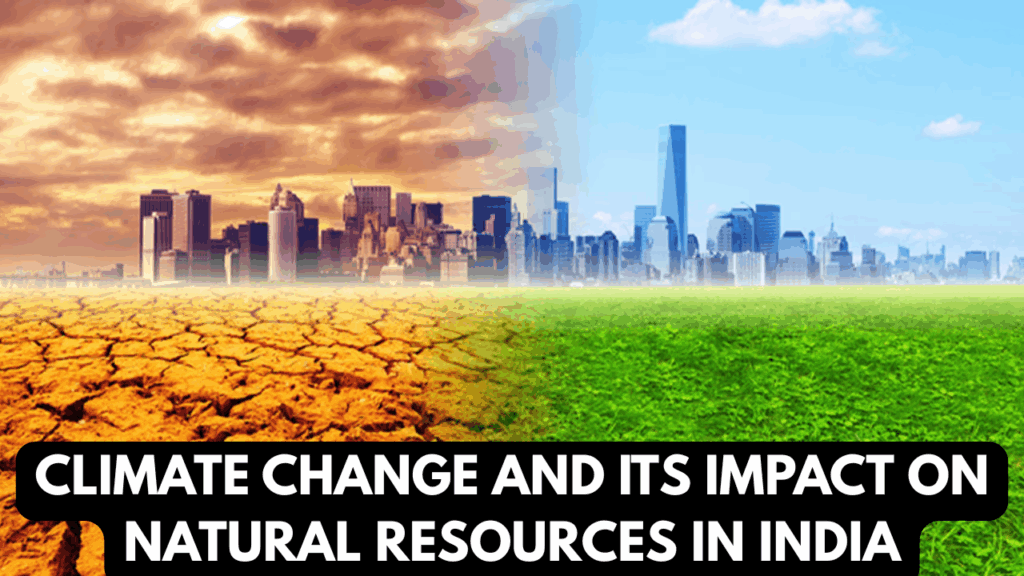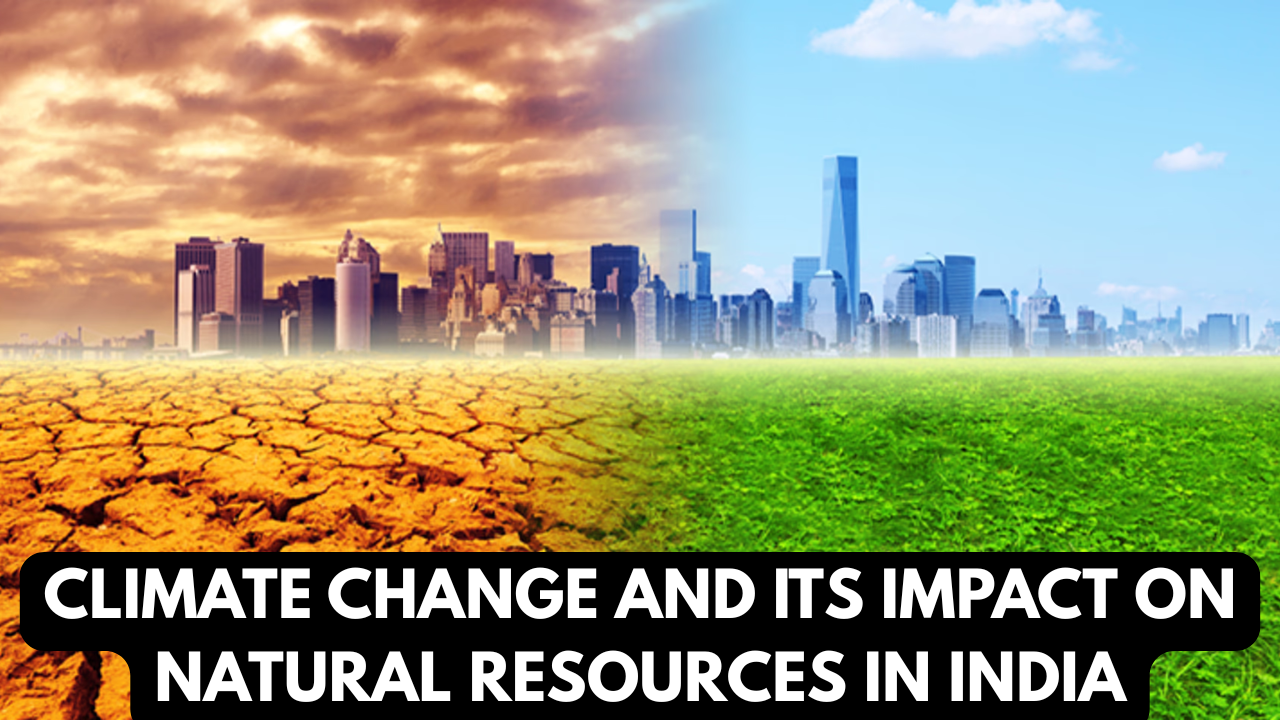
Climate change has become one of the most pressing global challenges, and its impact on a developing country like India is particularly significant. With its vast geographical diversity—ranging from the Himalayan glaciers to coastal ecosystems—India’s natural resources are highly vulnerable to rising temperatures, erratic rainfall, and extreme weather events. These changes not only affect the environment but also have profound consequences for agriculture, water availability, biodiversity, and human livelihoods.
The Link Between Climate Change and Natural Resources
Natural resources such as forests, water, soil, and biodiversity form the backbone of India’s economy and culture. Climate change alters their availability, quality, and productivity. Rising greenhouse gas emissions have triggered shifts in monsoon patterns, glacier retreat, sea-level rise, and biodiversity loss, making the management of these resources more complex.
Impact on Key Natural Resources
1. Water Resources
- Glacial Melt: The Himalayan glaciers, which feed major rivers like the Ganga and Brahmaputra, are receding rapidly.
- Erratic Rainfall: Monsoon variability leads to floods in some areas and droughts in others.
- Groundwater Stress: Over-extraction compounded by less recharge due to irregular rainfall.
2. Forests and Biodiversity
- Shifts in Vegetation: Forest ecosystems, particularly in the Himalayas and Western Ghats, are shifting with changing temperature and rainfall.
- Threatened Species: Tigers, elephants, and endemic flora face habitat loss.
- Invasive Species: Altered climates allow invasive plants and animals to dominate native ecosystems.
3. Agriculture and Soil Fertility
- Crop Yields: Staple crops like rice and wheat are highly sensitive to temperature fluctuations.
- Soil Degradation: Increased frequency of droughts and floods depletes soil nutrients.
- Fisheries: Ocean warming and acidification threaten India’s marine food chain.
4. Coastal and Marine Resources
- Sea-Level Rise: Threatens cities like Mumbai, Chennai, and coastal ecosystems.
- Coral Bleaching: Climate-induced ocean warming affects coral reefs in Lakshadweep and Andaman.
- Livelihood Risks: Millions of fisherfolk are at risk due to declining fish stocks.
5. Energy Resources
- Hydropower Projects: Reduced glacial flow impacts hydropower potential.
- Thermal Power: Water scarcity affects cooling requirements.
- Renewables: Solar and wind face variability due to erratic climatic patterns.
Sector-Wise Impact of Climate Change on Natural Resources
| Natural Resource | Impact of Climate Change | Consequences for India |
|---|---|---|
| Water | Glacial retreat, erratic monsoons, droughts | Drinking water shortage, agricultural stress |
| Forests & Biodiversity | Habitat loss, species extinction, invasive growth | Decline in ecological balance, eco-tourism loss |
| Agriculture & Soil | Reduced yields, soil erosion, pest outbreaks | Food insecurity, farmer distress |
| Coastal Ecosystems | Sea-level rise, coral bleaching, fish decline | Livelihood threats to coastal communities |
| Energy | Reduced hydropower, water scarcity for thermal plants | Energy insecurity, rising costs |
Case Studies from India
- Himalayan Glacier Retreat: The Gangotri Glacier has receded by over 20 meters per year, threatening long-term river water flow.
- Sundarbans Mangroves: Rising sea levels are submerging islands and destroying critical habitats for tigers and local communities.
- Agriculture in Punjab: Heat stress has reduced wheat yields, forcing farmers to adapt cropping cycles.
- Chilika Lake Fisheries: Climate-induced salinity changes have affected fish breeding and livelihoods.
Government Responses and Policies
India has adopted several frameworks to address the climate-natural resource nexus:
- National Action Plan on Climate Change (NAPCC): Includes missions on water, solar energy, and sustainable agriculture.
- State Action Plans on Climate Change (SAPCCs): Tailored regional responses to local challenges.
- National Water Policy: Promotes efficient water use and basin-level management.
- Green India Mission: Focused on afforestation and improving carbon sinks.
- Coastal Regulation Zone (CRZ) Rules: Aim to protect fragile coastal ecosystems.
Gaps and Challenges
- Implementation Deficit: Many climate policies remain underfunded and poorly executed.
- Data and Research Gaps: Limited localized climate impact assessments.
- Community Involvement: Insufficient participation of local communities in decision-making.
- Conflict of Interests: Rapid industrial growth often prioritized over resource conservation.
Future Strategies for Protecting Natural Resources
- Water Conservation: Expand rainwater harvesting and micro-irrigation techniques.
- Climate-Resilient Agriculture: Promote drought-resistant crops and sustainable farming practices.
- Forest Management: Strengthen biodiversity corridors and involve indigenous communities.
- Marine Protection: Enhance monitoring of fisheries and expand marine protected areas.
- Renewable Energy Expansion: Scale up clean energy while integrating climate adaptation strategies.
- Community Empowerment: Local governance should be central to climate adaptation efforts.
Overview Table
| Resource Area | Present Impact | Long-Term Risk | Required Action |
|---|---|---|---|
| Water | Glacial melt, droughts, floods | River system collapse | Basin-level water management |
| Forests & Biodiversity | Habitat loss, invasive species | Species extinction | Afforestation, corridor protection |
| Agriculture | Yield decline, soil degradation | Food insecurity | Climate-resilient farming |
| Coastal Ecosystems | Sea-level rise, coral bleaching | Coastal displacement | Stronger CRZ rules, community planning |
| Energy | Hydropower decline, water scarcity | Energy crisis | Diversify renewable energy |
| Human Livelihoods | Fisherfolk & farmers worst hit | Migration, poverty rise | Social safety nets, adaptation funding |
Conclusion
Climate change is reshaping India’s relationship with its natural resources. From shrinking glaciers and stressed rivers to declining crop yields and fragile coastlines, the impacts are far-reaching. While India has taken important steps through policies, missions, and international commitments, challenges in enforcement, research, and grassroots participation remain. Going forward, a holistic strategy integrating sustainable resource use, resilient infrastructure, and community empowerment will be key to safeguarding India’s natural wealth in a warming world.
FAQs
Q1. How does climate change affect India’s water resources?
Climate change accelerates glacial melt, reduces groundwater recharge, and disrupts monsoon patterns, causing both floods and droughts.
Q2. Which natural resources are most at risk in India due to climate change?
Water, agriculture, forests, coastal ecosystems, and energy resources are highly vulnerable.
Q3. What is India doing to address climate impacts on natural resources?
Through initiatives like NAPCC, afforestation drives, and CRZ rules, India is working to balance development with climate adaptation.

